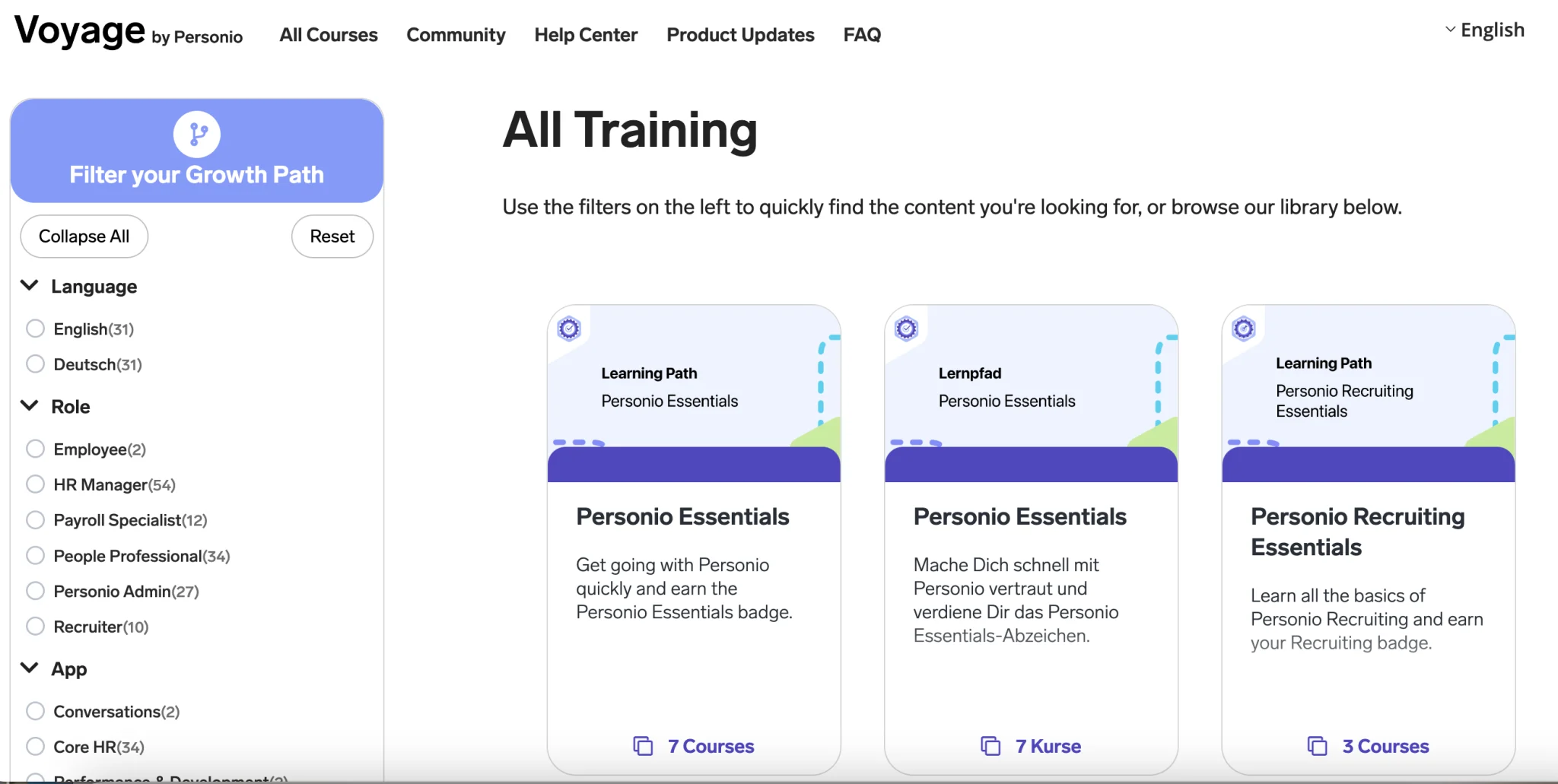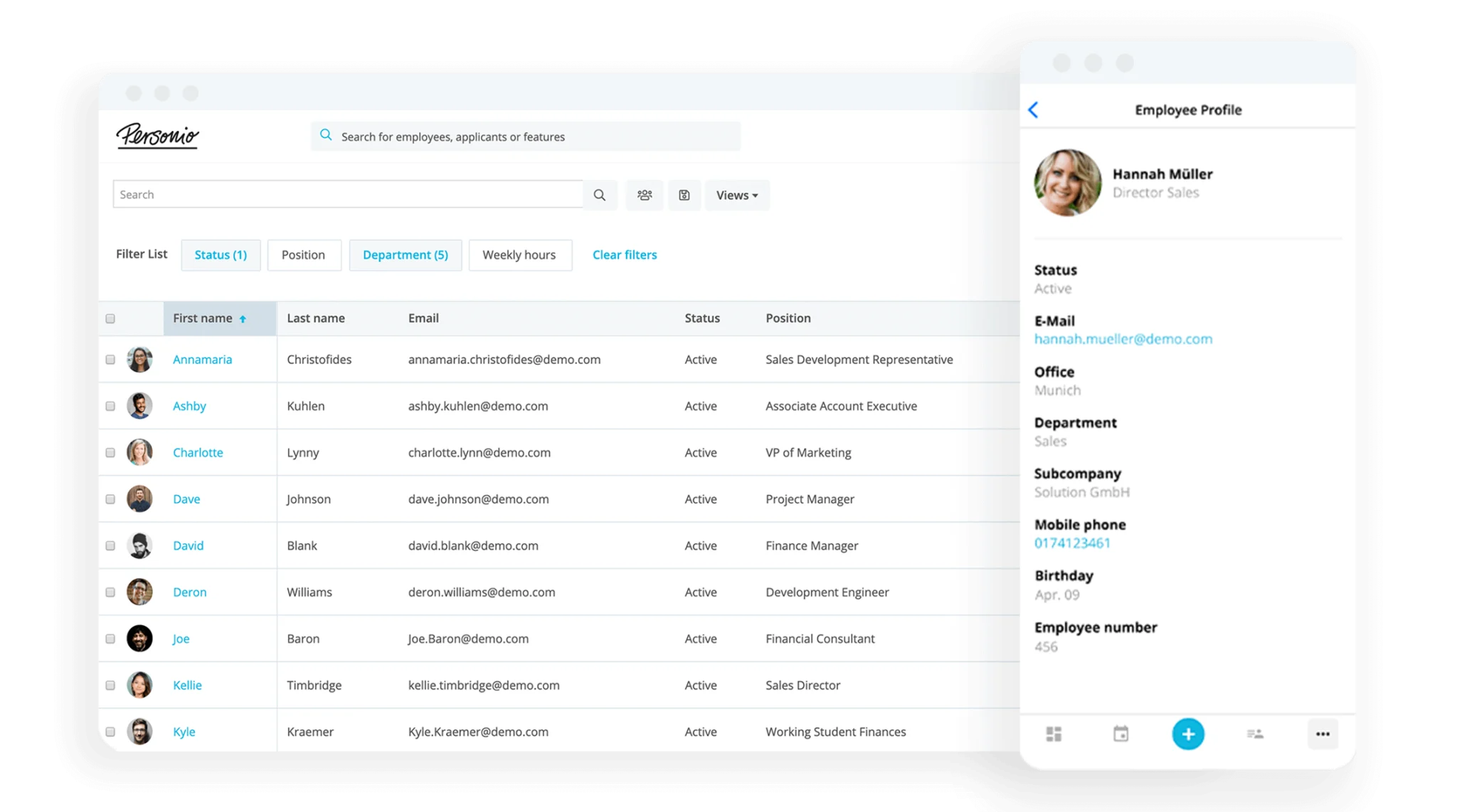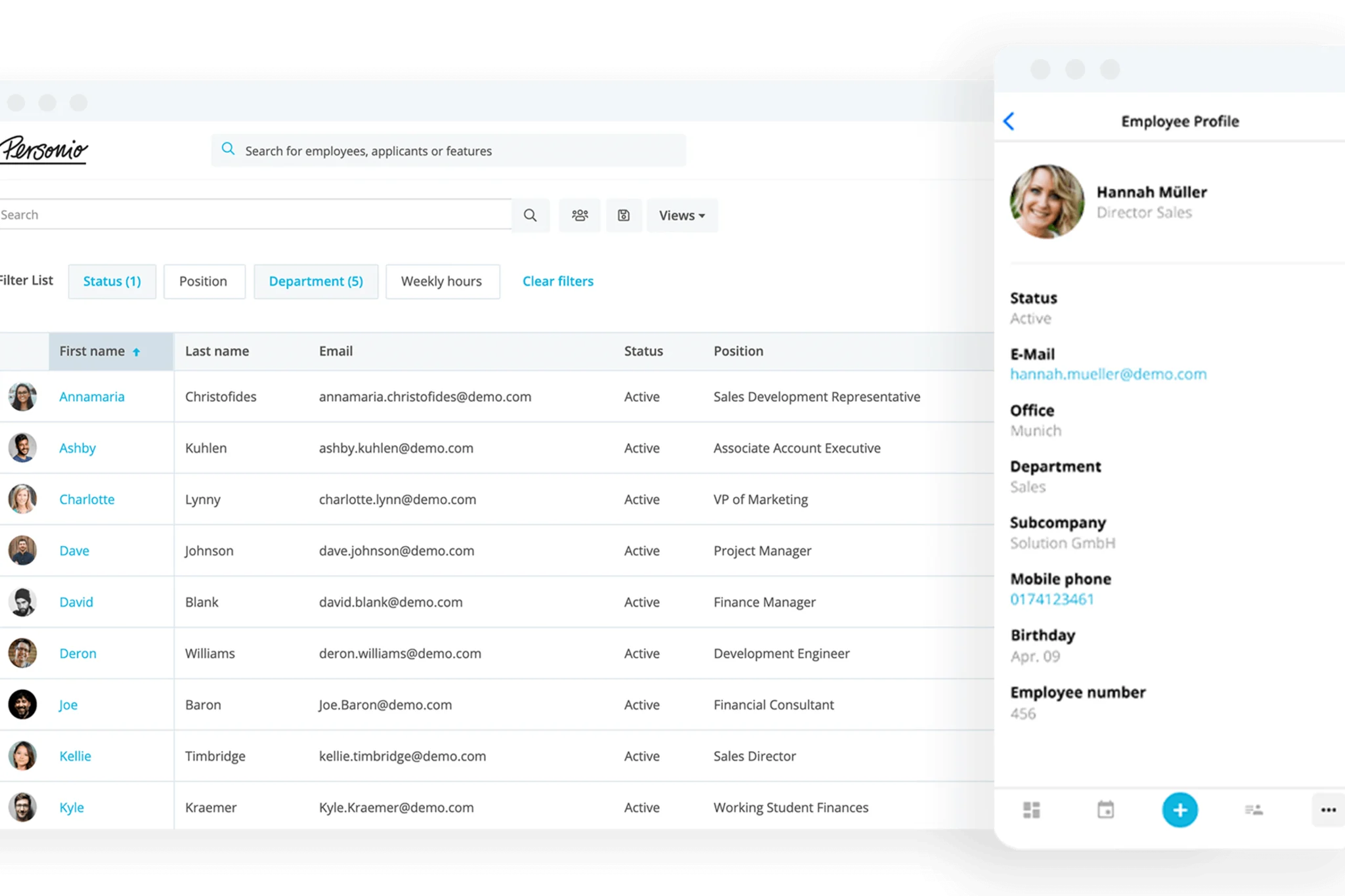Implementing An HR Software In 6 Weeks or Less

An HRIS implementation is the process of introducing a new HR software to your organisation. This is usually a strategic process that involves evaluating, choosing, testing and integrating a new solution into your organisation's tech stack.
In this article, we can talk you through how a great implementation process works and how Personio has constructed ours on the basis of those best practices.
You can gain a complete overview of implementing Personio's HR software right here.Contents
- 1How does HRIS implementation work?
- 2HRIS implementation checklist
- 3How long does it take to implement an HRIS?
- 4How do you transfer data during an HRIS implementation?
- 55 ways to optimise the HRIS implementation process
- 6How should teams prepare for HRIS implementation?
- 7A system that gets your teams up to speed
How does HRIS implementation work?
The process of implementing a human resources information system (otherwise known as an HRIS) starts by evaluating your needs and selecting the right solution.
For most teams, that process is going to look fairly similar and will follow a certain order:
Making a list of potential providers
Speaking with those providers in turn
Doing research through free trials or personalised demos
Considering your budget and HR software pricing
Making the final decision
And voila! Now you've made your decision and have a new HRIS that you're ready to implement. This is where the real fun begins.
What is the HRIS implementation process?
The process of implementing a new HR software takes place in five unique steps:
Step One: Designing | Talking through your unique needs and required customisations. |
Step Two: Building | Transferring important employee data or inputting it into your new system. |
Step Three: Testing | Piloting the system with people from across your organisation. |
Step Four: Rolling Out | Introducing your new system to the wider organisation and employees. |
Step Five: Iterating | Receiving continued support to help your new HRIS match your changing needs. |
At Personio, we view implementing an HR software as a holistic process. While there is a lot of great things you can do out of the box, it's important that your software is able to scale with your team and evolve with your needs.
HRIS implementation checklist
We put together this quick checklist to help guide your team through the process of implementing a new HR system.
Who is the main point of contact for this project?
Which other stakeholders need to be involved?
Who could help support or test your new software as a pilot group?
Does your new system meet your requirements?
Does it have the features you need or will need in the future?
Do they have a streamlined and supportive implementation process?
What are there data security standards like?
What is your timeline for implementing a new solution?
Do you need to cancel a solution you're currently using?
How much data do you need to transfer into your new system?
Can you transfer data from your old system into your new one?
Who will test your new system?
Employees?
Line managers?
Executives or senior leaders?
Schedule a testing period and then a 'go-live' date for your entire organisation?
Will you run trainings for your entire organisation?
To be clear, this is just a starting point and is not an exhaustive list of how implementation might look at your company. The most important thing is to partner with an HRIS provider that can help map out a journey that makes sense for your organisation.

How long does it take to implement an HRIS?
On average, Personio can be implemented as a new HRIS for your team in around six weeks. Of course, this may vary depending on the needs of your organisation.
That said, a proper implementation process will always be fully transparent and completely mapped out. There should always be a game plan in place.
Of course, your ability to implement a new HRIS will depend on some additional key factors worth considering:
Technical requirements – A strong HRIS will be user-friendly so that anyone on your HR team (or across your organisation) can use it with ease. No massive technical requirements or background knowledge is required, all it takes is a few lessons and you’re up and running!
Implementation support – Even the best HRIS will flounder if the implementation process isn’t designed specifically to support both it and an organisation. At Personio, we place particular emphasis on the implementation process, with outlined steps and timeframes for maximum transparency for new customers.
Employee self service (ESS) – Employees being able to add their own data to an HRIS is massive for HR teams everywhere, because the input process can be outsourced while still keeping a very high bar of quality. An HRIS with an ESS function is helpful because it can reduce the data transfer time drastically.
Best practice: A contact person is key. Who will lead the project? Who else will be involved? Try to plan by starting with six weeks of dedicated time to help make it a reality (and to avoid things lagging for too long).
How do you transfer data during an HRIS implementation?

Every company already has all the data they need at their disposal, it just depends on where it’s located. Sometimes in Excel, scattered across emails, or in an older system that needs refreshing. Data migration is a pressing topic for HR teams during the implementation phase, so it helps to outline how it works.
First and foremost, the data migration phase during HRIS implementation doesn’t have to go from 0 to 100. It can be done gradually and over time, and likely should be done with the help of ESS (again, another key requirement of a great HRIS).
The time required for data migration, overall, will depend generally on:
The size of the company
The complexity of the chosen HRIS software
The quality of current data
Data migration with Personio takes an average of four to eight weeks, from start to finish. During this time, HR and employees can continue to work normally, but it’s the kind of up-front investment that truly pays dividends in the long run.
Here’s an example: A recent customer has almost 1,000 employees, and the entire implementation (including data migration) was completed in six weeks flat. From then on, everything worked in the new system!
5 ways to optimise the HRIS implementation process
What are some of the ways that HR teams can optimise the processing of implementing an HRIS? Once you have your new solution chosen, and after knowing all the ins and outs, surely there are some ways to help make sure rollout is smooth.
We’d recommend the following five HR best practices, for your consideration…
Communication Is Key – It’s not enough to announce that your company is introducing a new solution. Make a big deal of it, lay out the benefits for every employee, and share your goals with management! A new HR software can, and should, benefit absolutely everyone, so communicate how that is the case.
Take A Top-Down Approach – Talk to managers and key stakeholders first, and then address the entire workforce. Gain the support of leadership and align with them, because it will make the implementation that much stronger — this will increase adoption and engagement rates because employees will feel expected to participate.
Define Roles & Rights – A great HRIS will offer different kinds of users and permissions, as is the case with Personio. Before implementation really gets going, start to identify roles in your company and what they should be allowed to do with regards to approvals and people processes. Have it sketched out but not finalized.
Involve Other Departments – Make sure that departments in your company have a seat at the table during the implementation phase (even if it’s during a bi-weekly alignment meeting, for instance). Finance, office management, and others will want to feel part of the process, so you should communicate actively and involve them.
Build A Project Plan – Your HRIS’ implementation team will have a plan that covers the nuts and bolts, but your organization should also devise a project plan that helps sketch out the entire process from start to finish (making note of key dates, decisions, and communication points with the entire company).
Keeping each of these in mind should help ensure a smooth implementation process, for all involved!
How should teams prepare for HRIS implementation?
The first step in implementing a new tool is ensuring you have the right tool in the first place. Especially with the responsibility that comes with introducing a new HR tool to your workforce, HR leaders need to understand the kind of digital transformation they want to undergo.
Here are two key questions to keep top of mind:
Does your team know what they need from an HRIS?
Have you tested and understood the tool completely?
Let’s dive a bit deeper into each of these questions…
1. Does your team know what they need from an HRIS?
HRIS implementation varies from tool to tool, but the first thing you need to do is understand whether you’re going to get everything you need from an incoming HRIS. Ask yourself some of the following:
Are you looking to digitise your administrative tasks?
Do you need a digital solution that helps recruit top talent?
Would you rather have many complex functions or a user-friendly interface?
It’s not just about the individual questions, though, but about the collective needs of your HR team and what a tool would be able to provide. In that sense, it helps to think about what you need today, what you might like, and what you might need or like in the future. Any prospective tool should have a little bit from each column.
2. Have you tested and understood the tool's capabilities?
You can only find out if an HRIS is right for your team by trying it out! To adequately prepare for any prospective HRIS implementation, take the time to test and involve stakeholders (executives, managers, employees) who would theoretically work with any incoming tool. A proper HRIS vendor will also afford you the chance to take their software for a spin, too.
A system that gets your teams up to speed
There's a reason why Personio's HRIS focuses so heavily on the implementation process. That's because it helps our customers get back to doing impactful work, rather than feeling the pinch of overwhelming administrative work.
From the field: Feedback from our own customers at Personio finds that the majority benefit from greater process clarity, automation, data storage and overall security. Personio also helps ‘raise the organisational profile’ of HR in the eyes of a company.
We know that great HR is better for business, and that HR does its best work when they're not bogged down. That's why we focus on a speedy and supportive process to get you up and running sooner than later.
If you want to learn more about Personio, we'd recommend speaking with an expert today or kicking off a free trial right this instant. You'll immediately be able to see what we mean when we say that great HR can't be hold back by administrative tasks.


